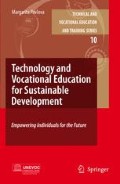Access this chapter
Tax calculation will be finalised at checkout
Purchases are for personal use only
Preview
Unable to display preview. Download preview PDF.
References
ATA (Appropriate Technology, Asia). (2008). The passive solar architecture. Retrieved March 7, 2008, from http://www.atasia.org.uk/ata.aspx
Biolytix. (2007). Biolytix Wastewater Treatment Technology. Retrieved November 17, 2007, from http://www.biolytix.com/detail.php?ID=16
Brennann, T. (2003). Globalisation and its terrors. London: Routledge. Calkins, P. (2008). The sufficiency economy at the edges of capitalism. Retrieved June 13, 2008, from the web http://www.sufficiencyeconomy.org/en/
Datschefski, E. (2008). Biothinking. Retrieved March 7, 2008, from http://biothinking.com/ top 40.htm
Elshof, L. (2003). Teacher’s interpretation of sustainable development. In J. Dakers & M. J. de Vries (Eds.), PATT-13 International Conference on Design and Technology educational Research (pp. 45–51). Glasgow, UK: Faculty of Education University of Glasgow.
Elshof, L. (2005). Teacher’s interpretation of sustainable development. International Journal of Technology and Design Education, 15(2), 173–186.
Goodman, P. (1970). New reformation: Notes of a neolithic conservative. New York: Random House.
Hamilton, C., & Denniss, R. (2006). Affluenza: When too much is never enough. London: Allen & Unwin.
Heselink, F., & Goldstein, W. (2000). The role of IUCN – the World Conservation Union – in shaping education for sustainability. In K. A. Wheeler & A. P. Bijur (Eds.), Education for a sustainable future: A paradigm of hope for the 21st century(pp. 123–141). New York: Kluwer Academic/Plenum Publishers.
Hoag, J. (2005). Perceptual positions. Retrieved October 20, 2006, from http://www.nlpls.com/ articles/perceptualPositions.php.
Holdsworth, I., & Conway, B. (1999). Investigating values in secondary design and technology education. The Journal of Design and Technology Education, 4(3), 205–214.
Horowitz, R. (2001). From TRIZ to ASIT in 4 steps. TRIZ Journal. Retrieved August 24, 2007, from http://www.triz-journal.com/archives/ 2001/ 08/ c/ index.htm.
Huckle, J. (2005). Education for sustainable development: A briefing paper for the Teacher Training Agency. Final draft Retrieved December 20, 2005, from http://john.huckle.org.uk/ publications_downloads.jsp.
Kantabutra, S. (2006). Relating vision-based leadership to sustainable business performance: A Thai perspective. Leadership Review, 6, 37–53.
Kantabutra, S., & Avery, G. C. (2005). Essence of shared vision: Empirical investigation. The New Zealand Journal of Human Resources Management, 5, 1–28.
Maclean, R. (2007). Education for sustainable development: Lessons from the private sector. The keynote address for the 12th International Business Forum 2007: Business and the Millennium Development Goals: Business Engagement for Governance. Washington, 8–10 October, 2007
Marashian, A. (2006). Design for life. Another Magazine for Men and Women, 10, 136.
Martin, M. (2003). Significance of sustainability issues for design and technology education: Rhetoric, reality and resources. In J. Dakers & M. J. de Vries (Eds.), PATT-13 International conference on design and technology educational research(pp. 165–169). Glasgow, UK: Faculty of Education University of Glasgow.
Miller, C. & Pitt, J. (2000). Live well, live wisely! Technology for sustainable development. London: Intermediate Technology Publications.
Nowakowski, L. (2007). Thai university graduate and undergraduate involvement in a participatory development project in Tak, Thailand. In proceedings of Reinventing Higher Education: Toward Participatory and Sustainable Development, The 11th UNESCO-APEID International conference, 12–14 December 2007, Bangkok, Thailand (CD, session 6.D.3).
Nuttavuthisit, K. (2005). Applying Sufficiency Economy Philosophy in Business Organizations: A Case of Pranda Jewry. Unpublished manuscript, Sufficiency Economy Unit, Office of National Economic and Social Development Board, Thailand.
O’Connor, J. (2001). The NLP workbook. A practical guide to achieve the results you want. London: Thorsons.
Parker, W. C., Ninomiya, A., & Cogan, J. (1999). Educating world citizens: Toward multinational curriculum development. American Educational Research Journal, 36(2), 117–145.
Pavlova, M. (2007). Two pathways, one destination: TVET for a sustainable future. Conference report for the UNESCO-UNEVOC virtual conference, 22 October–10 November. Retrieved January 7, 2008, from on: http://www.unevoc.unesco.org/
Piboolsravut, P. (2004). Sufficiency economy. ASEAN Economic Bulletin, 21(1), 127–134.
Pitt, J., & Lubben, F. (in press, 2009). The social agenda of education for sustainable development within Design & Technology: The case of the sustainable design award. International Journal of Technology and Design Education. Practical Action. (n.d.). Sustainable technology education project. Retrieved February 2, 2005, from www.stepin.org
QCA. (2007a). New secondary National Curriculum. Retrieved October 21, 2007, from http:// www.qca.org.uk/libraryAssets/media/D-and-T_KS3_PoS.pdf
QCA. (2007b). GCE AS and A level subject criteria for design and technology (September 2006). Retrieved October 21, 2007, from http://www.qca.org.uk/libraryAssets/media/qca-06–2845_ design_technology.pdf
Queensland Studies Authority. (2003a). Technology Years 1 to 10 Syllabus. Brisbane: Author.
Queensland Studies Authority. (2003b). Technology: Initial in-service materials. Brisbane: Author.
Queensland Studies Authority. (2003c). Technology: Years 1 to 10 Sourcebook. Brisbane: Author.
Queensland Studies Authority. (2007). Technology Studies Senior Syllabus. Brisbane: Author.
Schumacher, E. F. (1973). Small is beautiful: A study of economics as if people mattered. London: Blond & Briggs Ltd.
Sustainable Design Award. (2004). Retrieved January 30, 2006, from www.sda-uk.org.
Suwanwela, C. (2007). Roles of universities in sufficiency economy. In proceedings of Reinventing Higher Education: Toward Participatory and Sustainable Development, The 11th UNESCO-APEID International conference, 12–14 December 2007, Bangkok, Thailand (CD, session 6.D).
Turner, S. (in press, 2009). TRIZ/ASIT – Problem solving strategies for education and sustainable design. International Journal of Technology and Design Education.
UNESCO. (2005). United Nations Decade of Education for Sustainable Development 2005–2014. International Implementation Scheme. Draft, January 2005. Paris: UNESCO. Retrieved November 19, 2006, from http://unesdoc.unesco.org/images/0013/001399/139937e.pdf
Webster, K. (2004). Rethink, refuse, reduce . . . . Education for sustainability in a changing world. Shrewsbury: Field Studies Council.
Webster, K. (2007). Hidden sources: Understanding natural systems is the key to an evolving and aspirational ESD. Journal of Education for Sustainable Development, 1(1), 37–43.
Wicklein, R. (Ed.). (2001). Appropriate technology for sustainable living. 50th yearbook of the Council on Technology Teacher Education. VA: ITEA.
Author information
Authors and Affiliations
Editor information
Editors and Affiliations
Rights and permissions
Copyright information
© 2009 Springer Science+Business Media B.V.
About this chapter
Cite this chapter
Pavlova, M. (2009). Technology Education and ESD. In: Pavlova, M. (eds) Technology and Vocational Education for Sustainable Development. Technical and Vocational Education and Training: Issues, Concerns and Prospects, vol 10. Springer, Dordrecht. https://doi.org/10.1007/978-1-4020-5279-8_5
Download citation
DOI: https://doi.org/10.1007/978-1-4020-5279-8_5
Publisher Name: Springer, Dordrecht
Print ISBN: 978-1-4020-5278-1
Online ISBN: 978-1-4020-5279-8
eBook Packages: Humanities, Social Sciences and LawEducation (R0)

